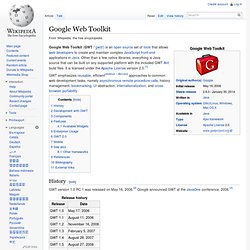

[GWT] Overview. Prerequisites You will need the Java SDK version 1.6 or later.
![[GWT] Overview](http://cdn.pearltrees.com/s/pic/th/started-overview-configure-73658218)
If necessary, download and install the Java SE Development Kit (JDK) for your platform. Mac users, see Apple’s Java developer site to download and install the latest version of the Java Developer Kit available for Mac OS X. Apache Ant is also necessary to run command line arguments. If you don’t already have it, install Apache Ant. If you have problems running Ant on the Mac, try setting the $JDK_HOME environment variable with export JDK_HOME=“/Library/Java/Home” Download and Install the GWT SDK On Windows, extract the files from the compressed folder gwt-2.7.0.zip. Unzip gwt-2.7.0.zip The GWT SDK doesn’t have an installer application.
Create your first web application GWT ships with a command line utility called [webAppCreator](doc/latest/RefCommandLineTools.html#webAppCreator) that automatically generates all the files you’ll need in order to start a GWT project. Windows Mac or Linux - you may need to make the script executable: [GWT] Overview. Welcome to the GWT Developer’s Guide.
![[GWT] Overview](http://cdn.pearltrees.com/s/pic/th/documentation-compatibility-73969176)
This guide introduces the key concepts, tools, and libraries you’ll encounter when building web applications with GWT. The topics in this guide span project organization, coding, debugging, testing, optimizing, and publishing your web application. Note - If you’re new to GWT and eager to start playing immediately, you might want to try the Quick Start. For specific technical details, see the Reference guide and Articles. Tutorials Create, build and run a GWT application – Create, build, debug and compile a sample application. Developer Guide Organize Projects – Describes conventions to identify which code is intended to run on the client browser, the server, or both Compile & Debug – Describes development and production modes Coding Basics – Describes GWT programming fundamentals Build User Interfaces – How to work with widgets, panels, the DOM, events, CSS, declarative UI and images.
[GWT] Google Web Toolkit. GWT emphasizes reusable, efficient[dubious ] approaches to common web development tasks, namely asynchronous remote procedure calls, history management, bookmarking, UI abstraction, internationalization, and cross-browser portability.

History[edit] GWT version 1.0 RC 1 was released on May 16, 2006.[2] Google announced GWT at the JavaOne conference, 2006.[3] In August 2010, Google acquired Instantiations,[4] a company known for its focus on Eclipse Java developer tools, including GWT Designer, which is now bundled with Google Plugin for Eclipse. Development with GWT[edit] GWT does not revolve only around user interface programming; it is a general set of tools for building any sort of high-performance client-side JavaScript functionality. GWT applications can be run in two modes: Development mode (formerly Hosted mode): The application is run as Java bytecode within the Java Virtual Machine (JVM). Components[edit] The major GWT components include: GWT Java-to-JavaScript Compiler Features[edit]